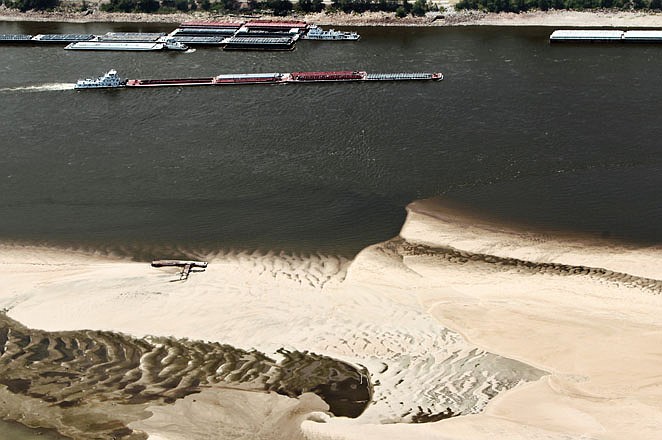By BILL DRAPER
Associated Press
KANSAS CITY, Mo. (AP) - Relentless heat and historically dry conditions are showing no signs of easing in Missouri, with the National Weather Service predicting seven to 10 days of 100-degree temperatures, including several expected to reach at least 105 degrees.
Lack of moisture is causing big problems for farmers and others who rely heavily on water for their livelihoods. Officials, however, said even an average amount of rainfall over the past few months would have made the heat difficult to bear.
"It's so dry, there's really not a lot of moisture left from the intense dryness of the last three or four months," said Chris Bowman, a meteorologist with the National Weather Service office in Pleasant Hill. "If we had gotten the rain we normally would get, we'd probably have dew points in the lower 70s. That would make it harder to heat up to the levels we're seeing now, but when you combine any kind of heat with high dew points, it gets uncomfortable really quick."
Gov. Jay Nixon on Tuesday said the U.S. Department of Agriculture has approved a request to designate all 114 Missouri counties as disaster areas. The designation allows eligible farmers to be considered for assistance from the federal Farm Service Agency, including receiving emergency loans.
Nixon asked for the federal assistance last week. Heat, dry weather and a lack of snow last fall and winter have contributed to the difficult conditions for Missouri farmers and ranchers.
Drought conditions have hit especially hard in the far southeast corner of the state, the Missouri Bootheel region, which the U.S. Drought Monitor shows to be in extreme drought.
Farmers are getting hammered, and eventually consumers will be feeling the pain, too, said John Schoen, a Cape Girardeau County dairy farmer with 500 cows on 800 acres that have been in the family since the mid-1800s.
"This is a very serious situation all the way through to the consumer," Schoen, 57, said. "I've only experienced probably three droughts in my lifetime and this is probably the worst."
Schoen said many of his cows drink from ponds and creeks on his land, and those waters are drying up.
"Streams in this part of the country are about 50 percent of what they should be," he said. "Ponds are probably at 30 percent of capacity."
He said feed costs are skyrocketing because of the drought, up by about 30 to 35 percent over the past four weeks. That will translate into higher beef costs in three to six months, Schoen said, and dairy prices will go up, too, but not as quickly.
"I would say as far as the bottom line, it's going to go from what was a profitable year to one of survival mode," Schoen said.
Nixon, who was touring several farms Tuesday, said drought conditions also were posing a fire risk across the state.
"The long-range forecast means not only will our fire responders need to continue their vigilance, Missouri farmers also must be ready for the long haul with this weather, even as we head into harvest season," Nixon said.
The National Agriculture Statistics Service reports topsoil moisture is short in almost all parts of the state, and creeks and streams are running dry. Missouri's corn crop has declined significantly in recent days and more than 90 percent of livestock pastures are in poor condition.
The National Weather Service said that through Monday, the temperature has hit at least 90 degrees for 20 straight days in St. Louis and for 24 straight days in Columbia. That is tied for the sixth-longest stretch in St. Louis, equaling marks set in 2007, 1921 and 1901. The string of 90-plus-degree days is the fifth-longest for Columbia.
Kansas City is in the midst of its driest July on record and is on pace to have its highest temperatures, Bowman said. The period from April 1 to July 15 is the second-driest ever for the city, he said.
The deaths of 17 St. Louis residents since June 28 have been blamed on the heat, while two St. Louis County deaths are also classified as heat-related.
Many of those who have died either didn't have a working air conditioner, or weren't using it, St. Louis health officials said. The city has also asked the Centers for Disease Control and Prevention to come up with a better nationwide heat death reporting system so that jurisdictions can better learn from each other about what leads to death in an era when air conditioning, either in home or at cooling centers, is readily available.
Jeff Hershberger, a spokesman for the Kansas City Health Department, said the city has one confirmed heat death and six that are being investigated as possibly heat-related. That's about where the city was at this point a year ago, he said, when there were 21 heat deaths before summer's end.
"With it being dry like this, the heat index is pretty close to the actual temperature," he said. "That's a really good thing. When it's humid, it always feels a lot hotter and it's harder for a body to cool down. The fact that it's more dry is making the heat more tolerable for us."
---
Associated Press writers Jim Salter in St. Louis and Chris Blank in Jefferson City contributed to this story.


